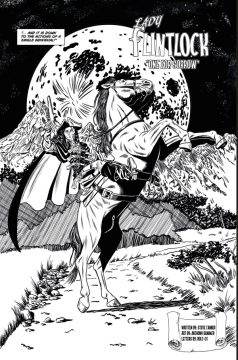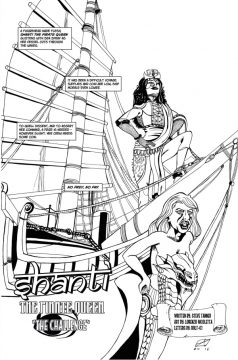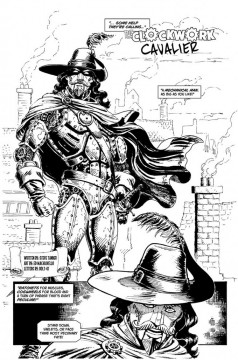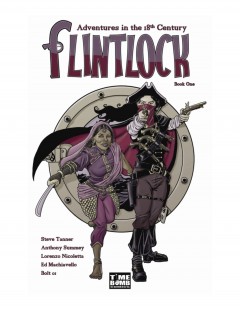“The era of highwaymen, pirates and thief-takers seems a shoe-in for creative inspiration” Steve Tanner on why he chose the 18th century for Flintlock
 Pirates, highwaymen and clockwork soldiers, set in the 18th century – it’s a pretty unique premise for an indie book and it’s why Steve Tanner’s Flintlock is one of the most interesting reads on the small press scene. Keen to find out why he set his book in the 1700s and the merits of a great female lead, we caught up with Steve to find out more.
Pirates, highwaymen and clockwork soldiers, set in the 18th century – it’s a pretty unique premise for an indie book and it’s why Steve Tanner’s Flintlock is one of the most interesting reads on the small press scene. Keen to find out why he set his book in the 1700s and the merits of a great female lead, we caught up with Steve to find out more.

Your book Flintlock is a trio of 18th century tales of action and adventure, what made you choose to set your stories in that period? Was it because it’s a rich vein of characters or a personal fondness for that time period?
Steve Tanner: The 18th Century holds a particular fascination for me, which in itself came from doing the research for the Dick Turpin horror comics I put out a few years ago. As a setting it’s overlooked for some reason, not just in comics but in general, which is why you can find lots of stories set in the middle ages or Victorian times but very little in between. It’s strange as the era of highwaymen, pirates, thief-takers and all the rest seem a shoe-in for creative inspiration! But in particular 1701 – 1800 brought some huge global changes that shaped the world as we know it today. American Independence for example, and the dawn of the industrial age. That’s just the big stuff – the smaller things that were happening over those one hundred years though, particularly in places like India and the Far East which we don’t really get to know about unless we major in those areas, is eye-opening. All eras bring great change, the difference in how the world was at the start of the 18th Century to when it gave way to the 19th Century is remarkable.
I’m also a huge fan of historical drama generally, not so much the quaint costume dramas but adventure stories that are a bit more meaty, and I’m a big fan of comics in a well-realised historical setting. I don’t mean the pseudo-medieval cod-fantasy stuff, what works around a gaming table doesn’t necessarily come across well as a comic, but stories inspired by real world settings and events.
Flintlock is also the first time I’ve attempted a series – seriously, it took me 9 years putting out books to feel ready to do that – and it was important that the book has a background that will be interesting to the reader but also, importantly for me, a background which seemed creatively rich enough to sustain my interest as well.
Your book features a pair of strong female characters, was it important for you to promote strong heroines rather than just make more books about male heroes?
ST: The seeds of Flintlock were sown at a major London convention I was selling at in 2015. I had an opportunity to take a look around and came across a huge booth from one of the bigger US publishers. The comics they had didn’t really appeal to me and they were also selling were slabbed variant covers, in particular there was one which was just a close up of one of a woman’s bare arse. That was it in a sealed plastic container. They were selling these for £20 a pop and folks were buying them.

You see, I remember weekly comics of the seventies and eighties. They were divided into boys and girls adventure titles, with the humour weeklies targeted at both. At the time I never read the girls comics of course but they routinely featured strong female characters that the readers could identify with, or at the least enjoy reading about. There’s a lack of traditional adventure characters in general these days, realistic female characters even more so.
Your book has a very classic feel, what your influences as a writer? Did you set out to give Flintlock a classic feel?
ST: As I touched on already, those classic adventure stories in the old British weeklies are a main influence on the Flintlock anthology and the stories within. Hopefully this comes across in the pacing, as each of the stories quite intentionally rattles along at a brisk gallop, and also the intentional use of black and white artwork pages rather than full colour. Those weekly comics always featured historical stories, so it’s very much a nod to that.

Each chapter has a different artist, was it important when you picked them that they had a more old fashioned feel, rather than be more contemporary or following the current fads? And how did you meet up with them?
ST: Time Bomb Comics gets a lot of submissions given how small a set-up it is, and all the initial Flintlock artists – Anthony Summey, Lorenzo Nicoletta and Ed Machiavello – come from that talent pool. Obviously with a series like Flintlock you have to have artists that both have a style suited to the kind of stories being told but also, and perhaps more importantly, are willing to rise to the challenge that entails in getting the period setting to look right. There’s a fair bit of research involved, and my scripts are embedded with any reference photos that I can find to help with that. The background detail is as important as the character anatomy, and the artists have been really up for getting that detail right. A couple of times I’ve asked for some pencil work to be redone as it’s felt not quite period to me. Perhaps the best example of how nerdy I can get about it was when I asked Anthony to redo some of his Lady Flintlock panels as they featured a type of tree that wasn’t introduced to English forests until after the 18th Century! That’s the exception rather than the norm though, most of the time my jaw just drops when I see how spot on it all is on the first take. Ed’s rendition of St Paul’s Cathedral in Book Two is a perfect example of that.
What’s your background in comics? Can you tell us a bit about other books you might have produced that fans of Flintlock would be interested in?
ST: I’ve written comics professionally now since the early 90s, although I had some self-imposed wilderness years since that time. I’m probably best known for Time Bomb Comics which I set-up in 2007 and brought me back from that wilderness, and of the comics I’ve written since then it’s probably the Dick Turpin horror adventures that (at least until Flintlock arrived on the scene) what most comics folks knew me for. “Dick Turpin and the Restless Dead” came out in 2008, the follow up “Dick Turpin and the Crimson Plague” was released in 2011 – a further one-shot “Dick Turpin and the Vengeful Shade” will be out hopefully in 2018, Elder Gods permitting. Of course it’s back to the 18th Century with those, which is why I think the Flintlock audience might like them too!

You’re a regular at comic cons and when we were at Leamington you were there with your family, is it important for you that your books are accesible to a family friendly audience so you can share it with your family?
ST: Not all the books I’ve released through Time Bomb have been family-friendly, Bomb Scares and Defiant are definitely not for the litt’luns, but that’s the beauty of comics – they really can be about anything and aimed at every audience. I think comic cons (and I include the multi-genre events as well as the more comics-centric when I use that term) should be family friendly and they should have something for everyone. I don’t bring my family to as many shows as I used to, part of that is perhaps I now attend far more than I used to, but I always ensure that a few shows a year are family outings. My daughter Sasha attended her first con when she was a few weeks old; she still comes along now and again and she still gets more attention than me when she does!
And what’s next for you? When will we be seeing Flintlock #3? And are there any other titles you are working on?
ST: Flintlock Book Three will be out either later this year or early next, really depending on how quickly the artwork can be produced. Originally I was hoping for a twice-yearly release schedule for the series, but it’s a case of giving the artists the time they need to create the pages. There’ll be some new character stories starting in Book Three as well, so I’m already looking forward to seeing how they’ll be received as I think they’re pretty unique.
I’ve also written the first Flintlock spin-off book that’s currently with the artist. It’s a self-contained one-shot, and I’m hoping to have it out by the end of August. More details to follow of course!
Finally 2017 is the tenth year of Time Bomb Comics (which may not seem that long but hopefully everyone knows that a year in self-publishing equals eight in the real world, right?) so will be marking that in September/October with a another one-shot that hopefully goes a little way to mark the occasion as well as giving a sense of closure to a decade of creating and publishing comics.
You can purchase Flintlock #1 and #2 from timebombcomics.com and you can follow Steve on twitter @timebombcomics


